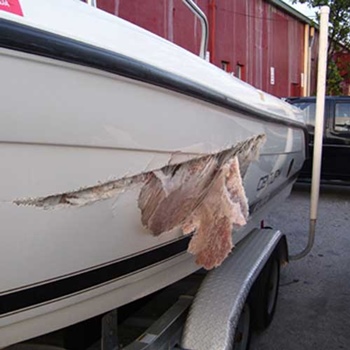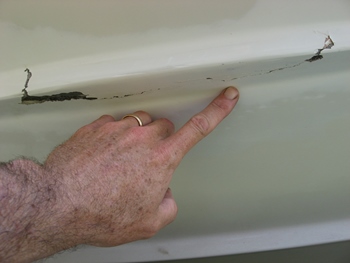Over time, boats may develop leaks, for various reasons. Fiberglass boats are prone to this issue in some situations and it’s important to solve the problem before you wake up one day that you’re sinking with your boat.
So, whether you notice the leak when you’re already in the boat or when you’re using your boat buffer, you must know what to do. Luckily, we have prepared some valuable information for you in this regard. Here’s how to identify and fix a leak in a fiberglass boat.
Finding the Leak
 First things first, you need to find where the leak is occurring. There are moments when leaks are caused by damage to the boat, which is the result of a collision. A crack or hole might have formed after the impact, and thus your boat might be full of water – or at least part of it.
First things first, you need to find where the leak is occurring. There are moments when leaks are caused by damage to the boat, which is the result of a collision. A crack or hole might have formed after the impact, and thus your boat might be full of water – or at least part of it.
However, that’s not always the case – in some instances, small leaks develop over time, which is more troublesome than leaks caused by collisions. With a collision, you have an idea of what happened and where the problem area is situated. But with random cracks that develop by themselves, you have no idea what the cause it. Therefore, you may be on the water already, and find out about the leak when your boat is already filling up with water.
Here are some tips to help prevent that:
1. Inspect the Boat Regularly
Is your boat leaking? In that case, finding where the leak is coming from is essential. You can discover the leak before you see water coming into the boat.
Perform regular inspections of the boat to make sure there aren’t any issues or things that have to be fixed. Also, if you find discoloration and corrosion of the metal fixings or some bubbling or breaking down paint, the chances are that there may be a leak.
2. Find the Leak Source
Have you figured out that your boat is leaking? Then you have to find the source of the leak.
You can purchase an ultrasonic leak detector that helps find the issue. A can of compressed air can also help identify the leak. Sprinkle baby powder onto the boat’s outer part and use compressed air to blow on the location from the inside of the boat. If the baby powder is disturbed in any way afterward, a leak must be there.
How Can You Repair a Fiberglass Boat Leak?
Once you discover a leak in your boat, fixing it is the very next step. Many people choose to simply take the boat to the shop and get it repaired professionally, but this is not always necessary. With some skill, you can fix the leak yourself – so, you shouldn’t worry if you’re in an emergency and need your boat fixed right now. Besides, if you become a boat owner, you should know some basics about repairing simple leaks.
Leaks can happen when you least expect it, such as when you’re already on the boat, away from the shore. This is when you need the boat fixed instantly because it’s a very dangerous scenario where every second matters. Whoever is in charge of the boat in this situation must know what to do to stop the water from coming into the boat and make things safe.
Now, here are some ideas for emergency and long-term reparations to the boat.
1. Emergency Reparations
As you can probably imagine, emergency repairs are the kind you need to make in an instant. That’s when you’re in a risky situation and not doing something about it can put your life in danger.
The goal with this type of leak is to slow down the incoming water for as long as possible until you’re able to go to a safe place. One thing you can do is using a collision mat. This is basically a heavy-duty mat that you can pull under the boat and cover the damage that has occurred, slowing down the leak or even stopping it, depending on how severe it is. So, make sure that before you get on your boat, you purchase a collision mat and bring it with you wherever you go sailing.
Another thing you can do for temporary reparations is using a sealant spray. With this one, you should know that it will only work with small damage and it won’t fix a big hole in your fiberglass boat. If there are small cracks or unseizable holes, the sealant will act as a band-aid until you go back on the shore and can start fixing the damage.
2. Long-Term Reparations
 Long-term reparations are meant to actually fix the issue forever, so you won’t be worried about it anymore and so that there will be no water coming into the boat.
Long-term reparations are meant to actually fix the issue forever, so you won’t be worried about it anymore and so that there will be no water coming into the boat.
When your fiberglass boat is damaged and needs long-term reparations, you can choose to keep the boat in the water or take it out. Out-of-water reparations will allow you to replace the fittings and make sure the leak is stopped once and for all, after which you can add some more sealant just to be sure. If there’s a crack and not a massive hole causing the leak in the fiberglass of the hull, you will not have to replace the entire fitting.
As for in-water repairs, they are often done when there are leaks occurring from somewhere above the waterline. This is possible when leaks take place because of window frame cracks or other such issues.
The Bottom Line
If you want to fix your fiberglass boat, you have to find out the source of the leak first and determine whether you can do it yourself or take have to take it to a professional. Just follow the tips in this article and fixing the leaks in your boat won’t be such a headache.